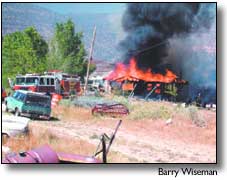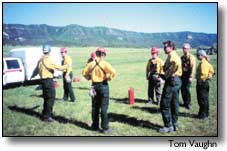|
June 12, 2001
By Tom Vaughan Mancos Times Editor A lightning-sparked fire on the rugged east slope of Menefee Mountain kept firefighters hopping over the weekend and into Monday. Their efforts were, in part, hampered by the commitment of scarce resources to other fires in the region, a scenario reminiscent of last summer’s disastrous forest fires on Mesa Verde. Friday evening’s half-acre flare became two acres by Saturday morning, six on Saturday evening, 10 by Sunday morning and roughly 40 to 60 acres Sunday evening, despite ground attacks and aerial bombardment with water and retardant during the daylight hours on Saturday and Sunday. No information was available at press time Monday as to the progress of the fire, but none of it had been contained or controlled as of Monday morning. The lightning strike was in a BLM Wilderness Study Area — a roadless section of steep slope on the west edge of Joes Canyon, less than two miles south of Flint Rock Point. Ground crews have had to be airlifted in by helicopter, along with their water, equipment and other supplies. Though the fire has stayed mostly on the east slope of Menefee Mountain, on occasion it has come to the crest of the ridge, pouring smoke westward down the slope into Webber Canyon.
The area is vegetated with ponderosa pine, piñon/juniper and oak brush typical of an 8,000-foot elevation. According to incident commander Tim Oliverius on Monday, much of the expansion of the fire has been into oak brush. There has been little torching, Oliverius said, but as the fire creeps along the ground under the oaks, it dries the trunks and leaves above it and creates incendiary conditions. Firefighters at the helicopter base camp in Webber Canyon cited wind as a problem in getting the blaze under control. Weather forecasts that read "mostly sunny and breezy," as Monday’s did for the Durango area, are not likely to allow forest managers or firefighters to rest well. Scott McDermid, Mesa Verde National Park helitack foreman, was the incident commander Saturday. McDermid said the interagency ground crew working the fire Saturday and Sunday included five persons from the Ute Mountain Agency at Towaoc, five members of the Mesa Verde helitack crew and nine from the Dolores Forest Service office. Two Bell Ranger helicopters were assigned to the fire Saturday, ferrying personnel and making water drops. The first air attack came Saturday; the helicopter based at Mesa Verde was down for routine maintenance when the initial fire report came in on Friday. A Ute Mountain Ute helicopter on its way to give additional help Saturday was diverted to a blaze on the Jicarilla Apache Reservation in northern New Mexico. One of the helicopters on-site Saturday afternoon was preparing its crew to leave for a fire in the Norwood area when that diversion was canceled. By Monday morning, a Puma helicopter was on hand to transport firefighters to the fire. A single-engine air tanker dropped retardant on the Menefee Fire Saturday, between drops on other fires in the region. The SEAT was supplemented by a heavy air tanker on Sunday, until the SEAT had mechanical problems. The local National Park Service, Forest Service and Ute Warrior firefighter crews were augmented Monday by the Alpine and Roosevelt hot-shot crews, with their vehicles and equipment. Oliverius said the local crews would be rotated off the fire Monday afternoon. The plan Oliverius laid out at the Monday morning briefing was to get the fire contained Monday, conduct mopping-up operations Tuesday and send the crews home late Tuesday. "Hopefully, we’ll have you out of here by tomorrow evening," he told the crews. Three NPS archaeologists were sent in to the fire zone Monday — Julie Bell, Kathi Kramer and Laura Martin. Their job is to detect historic and prehistoric sites in this previously unsurveyed area and guide firelines around them as much as possible. Looking ahead, many fear that Southwest Colorado may be headed for a replay of the 2000 fire season. Though the Bureau of Reclamation statistics for Jackson Gulch Reservoir show it is at capacity (9,948 acre-feet at elevation 7,825) and well above the 1949-2000 average end-of-month level for May (8,832 acre-feet), other indicators suggest a dry summer. The Natural Resources Conservation Service reports that, as of June 1, snowpack in the San Juan, Animas and Dolores basin was only 32 percent of average. The statewide snowpack was 24 percent of average, attributed by the NRCS to "a warmer- and drier-than-normal weather pattern across the state that continued throughout most of May." |
||||
|
Copyright © 2001 the Cortez Journal.
All rights reserved. |

